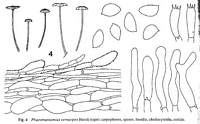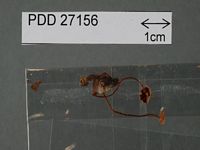|
 Tubaria verrucipes Tubaria verrucipes
SynonymsPhaeomarasmius verrucipes
BiostatusPresent in region - Indigenous. Non endemic
Images (click to enlarge) | 
Caption: Dried type specimen
Owner: Herb PDD |
Article: Horak, E. (1980). Fungi Agaricini Novazelandiae. VIII. Phaeomarasmius Scherffel and Flammulaster Earle. New Zealand Journal of Botany 18(2): 173–182 (http://www.rsnz.org/publish/abstracts.php).
Description: Pileus-12 mm, hemispheric or convex when young, soon becoming expanded with distinctly depressed centre; pale argillaceous near substriate margin, pale brown at disc; velutinous to minutely fibrillose or floccose at centre, smooth towards margin; dry, vaguely hygrophanous, veil remnants none. Lamellae (L 6-14, -3) crowded, broadly adnate (in young specimens) to subdecurrent-arcuate (in aged specimens); pale argillaceous with distinct rust-brown tinge, edge albofimbriate. Stipe-35 x -1 mm, cylindric, equal, stiff but elastic, slender; concolorous with pileus, brown at base; entirely covered with coarse floccose to wart-like squamules; dry, hollow, single in groups, cortina remnants none. Context pale brown. Odour not distinctive. Spores 6-8 x 3.5-4.5 µm, ovoid to subamygdaliform, mucro often indistinct, pale brown, membrane thin-walled, smooth, germ pore absent. Basidia 20-30 x 5-6 µm, 4-spored. Cheilocystidia 30-65 x 7-10 µm, fusoid to subclavate, hyaline, membrane thin-walled, sometimes forked at apex. Pleurocystidia absent. Caulocystidia like cheilocystidia, membrane often thick-walled, encrusted with brown pigment. Cuticle a trichoderm of cylindric to ovoid hyphae, terminal cells not or little differentiated (cystidioid), membrane not gelatinised, encrusted with brown (KOH) pigment. Clamp connections present on septa.
Habitat: on rotting organic debris (Blechnum, Dicksonia, Neopanax arboreum (Murr.) Allan. New Zealand. (Papua New Guinea).
Notes: The macroscopic appearance of this fungus (and in particular the tough consistency of its carpophores) suggests Marasmiellus sp. or Marasmius sp. The microscopic features (e.g., shape and colour of the spores, morphology of the cheilocystidia, structure and pigmentation of the cuticular hyphae), however, are those of typical Phaeomarasmius.
In New Zealand this species is met on different kinds of organic debris in dense and wet forests. It is also reported from similar habitats in Papua New Guinea (Horak 1979).
|